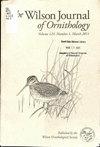鸟类和蜜蜂:西部王鸟(Tyrannus verticalis)更喜欢雄蜂
IF 0.5
4区 生物学
Q4 ORNITHOLOGY
引用次数: 1
摘要
摘要:我们观察了一对西部王鸟(Tyrannus verticalis)利用机会在蜜蜂(Apis mellifera)群体上觅食。他们栖息在一个地方,可以很好地观察工蜂和雄蜂(雄蜂)进出蜂群的飞行模式,并仔细观察蜜蜂的飞行。当发现一只雄蜜蜂时,它们迅速从栖木上飞下来,抓住那只蜜蜂,然后回到栖木上,把完整的蜜蜂头朝下吞了下去。在吞咽之前,他们不会将蜜蜂或其腹部撞击基质。对栖地下收集的反流颗粒的分析发现了149只雄蜂的头部胶囊,而没有工蜂。这对西部王鸟能够区分有刺的、令人讨厌的工蜂,并选择美味的、不受防御的飞行中的雄蜂。RESUMEN(西班牙语)Observamos cómo una pareja de tiranos垂直暴龙as provechaba las oportunades de forrajeo en una colonia de abeja melífera(蜜蜂Apis)。Las aves se percharon en unsique les brindaba,当访问视觉patrón de vuelo de Las abejas obreras y machos (zánganos) que entraban y salían de la colonia y observaban atamente los vuelos de Las abejas时。Cuando alguno avistaba un macho, abandonaba rápidamente sujetabla abeja, sujetabla abeja, volvía supercha y tragaba la abeja完好无损的cabeza。No golpeaban la abeja ni su腹部对照el基底antes tragársela。Análisis de egagrópilas regurgitadas collectadas debajo del sitio de percha mostraron cápsulas cefálicas de 149 zánganos de abejas y ninguna de abejas obreras。垂直暴龙(Tyrannus verticalis)有能力区分不同的人,有能力区分不同的人,有能力区分不同的人,有能力区分不同的人,有能力区分不同的人,有能力区分不同的人tenían sabor,有能力区分不同的人zánganos,有能力区分不同的人,有能力区分不同的人últimos。昆虫科:蜜蜂科,depredación,可降解,昆虫科aguijón。本文章由计算机程序翻译,如有差异,请以英文原文为准。
The birds and the bees: Western Kingbirds (Tyrannus verticalis) prefer drone honeybees
ABSTRACT We observed a pair of Western Kingbirds (Tyrannus verticalis) take advantage of opportunities to forage on a honeybee (Apis mellifera) colony. They perched on a site that afforded them good visual access to the flight pattern of worker and male (drone) bees entering and leaving the colony and attentively watched the bee flights. When a male bee was spotted, they quickly flew off their perch, grabbed the bee, returned to the perch, and swallowed the intact bee headfirst. They did not strike the bee or its abdomen against the substrate before swallowing. Analysis of regurgitated pellets collected under the perch site revealed head capsules of 149 drone bees and none of worker bees. This pair of Western Kingbirds was capable of distinguishing between stinging, distasteful worker honeybees and chose palatable, undefended drones in flight. RESUMEN (Spanish) Observamos cómo una pareja de tiranos Tyrannus verticalis aprovechaba las oportunidades de forrajeo en una colonia de abeja melífera (Apis mellifera). Las aves se percharon en un sitio que les brindaba buen acceso visual al patrón de vuelo de las abejas obreras y machos (zánganos) que entraban y salían de la colonia y observaban atentamente los vuelos de las abejas. Cuando alguno avistaba un macho, abandonaba rápidamente su percha volando, sujetaba la abeja, volvía a su percha y tragaba la abeja intacta de cabeza. No golpeaban la abeja ni su abdomen contra el substrato antes de tragársela. Análisis de egagrópilas regurgitadas colectadas debajo del sitio de percha mostraron cápsulas cefálicas de 149 zánganos de abejas y ninguna de abejas obreras. Esta pareja de tiranos Tyrannus verticalis era capaz de distinguir en vuelo las obreras, que picaban y que no tenían sabor, de los zánganos, apetecibles e indefensos, para elegir estos últimos. Palabras clave: Apis mellifera, depredación, desagradable, insectos de aguijón.
求助全文
通过发布文献求助,成功后即可免费获取论文全文。
去求助
来源期刊
CiteScore
0.90
自引率
0.00%
发文量
133
审稿时长
4-8 weeks
期刊介绍:
Aims & Scope
For more than a century, the Wilson Ornithological Society has published a scholarly journal with form and content readily accessible to both professional and amateur ornithologists. The Wilson Journal of Ornithology is a quarterly publication consisting of major articles based on original studies of birds and short communications that describe observations of particular interest. Each issue also includes reviews of new books on birds and related subjects, as well as ornithological news. Through an endowment from the late George Miksch Sutton, each issue of the Journal includes a full color frontispiece. Each current volume consists of approximately 500 pages. The principal focus of the Journal is the study of living birds, their behavior, ecology, adaptive physiology and conservation.
Although most articles originate from work conducted in the western hemisphere (a large portion of the research on Neotropical birds is published here), the geographic coverage of the journal is global. The Journal is internationally recognized as an important, major journal of ornithology. The Edwards Prize is given annually for the best major article published during the previous year.
The Wilson Journal of Ornithology was formerly named the Wilson Bulletin.

 求助内容:
求助内容: 应助结果提醒方式:
应助结果提醒方式:


